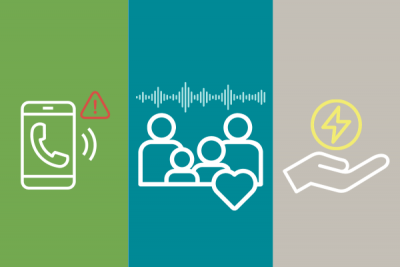Communication Plan
opt-in for emergency alerts
It is critically important to stay informed when any emergency strikes. Public agencies are typically disseminating information throughout an emergency. The best step you can take is to opt-in to receive emergency alerts. Visit PublicAlerts.org to sign up for emergency notifications via text, phone or e-mail. You’ll want to check that your cell phone has Wireless Emergency Alerts enabled. To keep up on hazardous weather conditions, you can visit TripCheck.com or go to NOAA Weather Radio which delivers official Weather Service warnings, watches, forecast, and other hazard information based on location.
family communication plan
Make and practice a family communication plan. You may not be with your family members during an emergency. You need a plan that outlines how you will get to a safe place and how family members can contact and/or locate one another during an emergency. Include a family contact list with at least one out-of town contact who may be able to reach others more easily in an emergency. Practice your plan with family members. Fill out the family locator form provided at tvfr.com by our friends at Tualatin Fire and Rescue.
Make sure all phones are programmed with contact numbers for daycare facilities, schools, employers, gyms, friends and relatives, co-workers, neighbors and others who may need to be reached to locate family members. Distribute hard copy as back-up to keep in briefcases, backpacks, purses, wallets, etc. Decide on safe, familiar places where your family can reunite. Make sure locations is accessible for pets and household members with mobility limitations.
Establish multiple ways to connect. In an emergency some ways of communicating may be unreliable. To increase your chances of staying in contact, follow these tips.
- Besides programming contact numbers, also have smartphone access to e-mail, social media platforms, and other apps and web-based tools.
- Text Before Calling. Texts use less bandwidth than calling and may have a higher chance of getting through when a communications network is overloaded.
- Keep Power in Reserve. Have multiple battery operated phone chargers on hand in the event of a power outage. Turning on one device at a time can help conserve battery life should electricity be down for an extended period.
- Use Social Networks to Establish Contact. Facebook offers Crisis Response, a place where people can tell friends they’re safe, ask for or offer help, and find resources and other information for specific crises.
- Subscribe to Receive Wireless Emergency Alerts (WEAs). Alerts issued by authorized government authorities can provide timely information about emergencies in your area. The wireless trades association, CTIA (ctia.org), lists WEA-compatible devices; sign up to receive alerts at publicalerts.org.
Create, Share, Update!
- Make copies. Create and share copies of your family’s contact information. Keep copies everywhere they might be needed, such as at home, in vehicles, at work, in backpacks, wallets, and phones etc.
- Share The Plan. Being on the same page will better prepare everyone to work together during a crisis. Share plans with babysitters, neighbors, friends, and someone outside the area.
- Keep It Up to Date. An outdated plan may cost precious time in an emergency. Ensure that the information that you share in your family’s locator/ communication plan is current.
communication without power
Prepare to communicate without power. Your emergency supplies should include a battery-powered or hand crank radio so you can receive emergency information even when the power is out. Keep extra batteries and cell phone chargers on hand, and get in the habit of keeping cell phones, laptops, and other devices fully charged. To conserve battery power, switch devices to power-saving mode, dim the brightness of screens, close apps, and turn them off when not in use. Limit calls or texts during an emergency. Using text messages or e-mail instead of calling conserves cell phone batteries and reduces congestion on cellular networks.
Join Forces: Communicate with your Neighbors
In the immediate aftermath of any emergency, the first responders may be good neighbors who live or work nearby. Organizing with neighbors and learning to pool resources, skills, and equipment builds resilience, and can get everyone back on their feet faster. Here are a few ways neighbors can come together to prepare for emergencies:
- Learn how to secure your homes after a disaster to minimize damage and protect your households and neighborhood.
- Create a neighborhood contact list. Meet your neighbors and compile a list of residents, noting pets and those who may need special assistance, like older adults or people with disabilities
- Create a neighborhood map identifying the locations of natural gas and propane tanks. Most fires after disasters are caused by gas leaks. Knowing how and where to shut these off can save lives and property.
- Create a communications network to share updates on events and emergencies in the area.
- Work together to assess the damage to your neighborhood after a disaster and take appropriate action to save lives, reduce injuries, and reduce property damage.
- Identify neighbors with vital skills and equipment. Knowing which neighbors have unique skills and supplies that the community can tap into can make it easier for people to understand how to pitch in and be helpful during a time of stress.
- Highly-sought skills include first-aid, fire fighting, or search-and-rescue skills, childcare/elder care skills, carpentry, electrician and/or plumbing skills, organizing/communications skills.
- Useful equipment includes ladders, chain saws, crowbars, drills, shovels, and other tools to remove hazards or to repair appliances, vehicles, plumbing etc., first aid supplies and medical equipment, tents, spare bedding, a power generator or batteries, communications devices such as walkie-talkies or radios.





